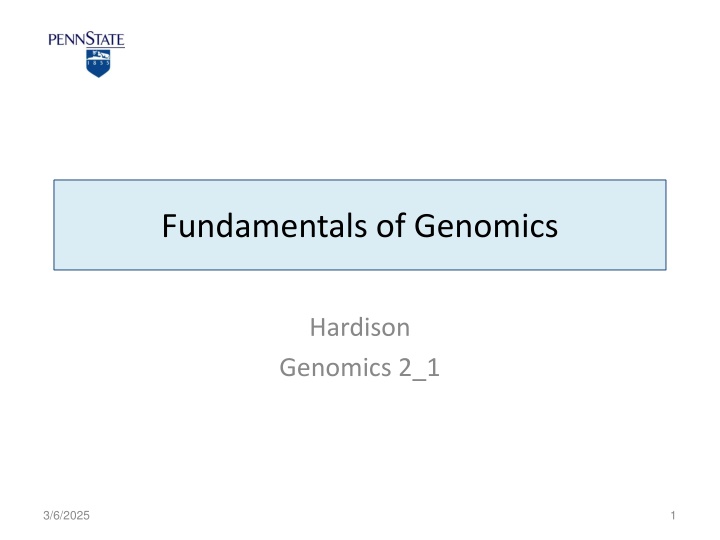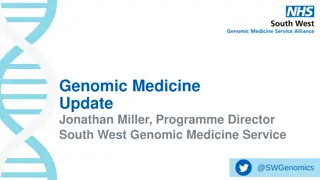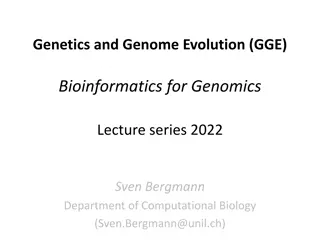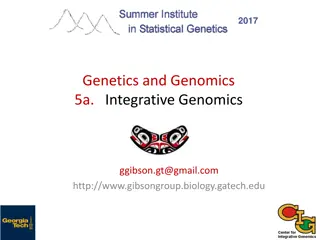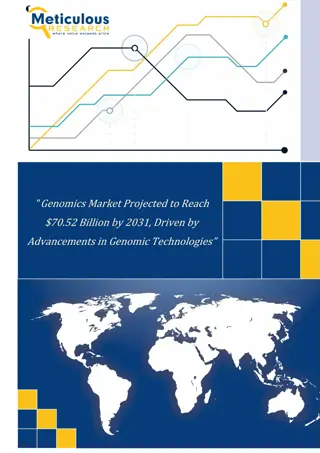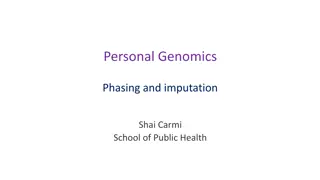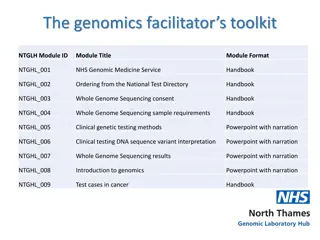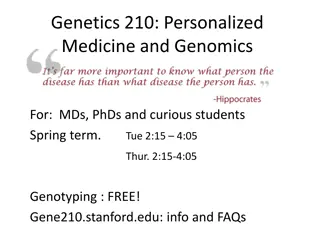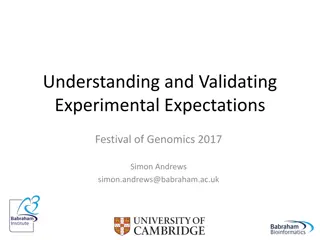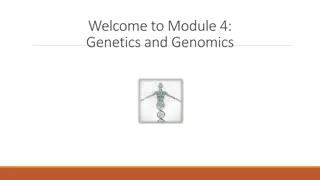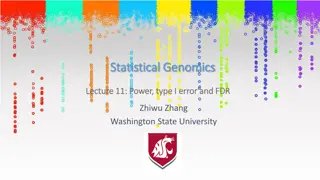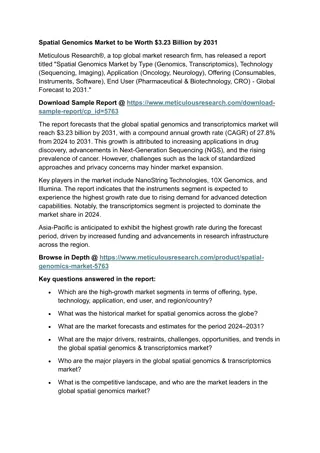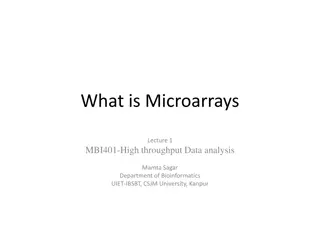Fundamentals of Genomics
Human genome, genetics, biochemistry, and the Genomics Revolution are explored in this content. Insights into genomics features, phases, and the interaction between various scientific disciplines are discussed. The focus is on understanding the complexities of genomes and their implications on biological sciences.
Download Presentation

Please find below an Image/Link to download the presentation.
The content on the website is provided AS IS for your information and personal use only. It may not be sold, licensed, or shared on other websites without obtaining consent from the author.If you encounter any issues during the download, it is possible that the publisher has removed the file from their server.
You are allowed to download the files provided on this website for personal or commercial use, subject to the condition that they are used lawfully. All files are the property of their respective owners.
The content on the website is provided AS IS for your information and personal use only. It may not be sold, licensed, or shared on other websites without obtaining consent from the author.
E N D
Presentation Transcript
Fundamentals of Genomics Hardison Genomics 2_1 3/6/2025 1
A human genome (male) The genome is all the DNA in a cell. All the DNA on all the chromosomes. 3 billion bp = 3 Gb Chr1 247 Mb Chr12 132 Mb Y Chromosome Chr22 50 Mb 2
Genomics, Genetics and Biochemistry Genetics: study of inherited phenotypes Mainly focused on genes Genomics: study of genomes Covers all genes but all non-genic DNA as well Biochemistry: study of the chemistry of living organisms and/or cells Sequencing a genome is a comprehensive determination of a biochemical structure Also use sequencing technologies to examine many biochemical features associated with genomes (epigenetic features such DNA methylation, histone modification, polymerase binding, etc.) Revolution launched by full genome sequencing Many biological problems now have finite (albeit complex) solutions. New era will see an even greater interaction among these three disciplines 3/6/2025 3
Features of Genomics Complete: Global studies Large datasets Finite: Work with a defined parts list All genes (coding for protein or not) All DNA segments needed to regulate gene expression All DNA segments needed to maintain chromosome replication and integrity Integrative Multiple disciplines Biology, biochemistry and molecular biology, genetics, statistics, computer science, bioengineering, 3/6/2025 4
The Genomics Revolution Know (close to) all the genes in a genome, and the sequence of the proteins they encode. BIOLOGY HAS BECOME A FINITE SCIENCE Hypotheses have to conform to what is present, not what you could imagine could happen. No longer look at just individual genes Examine whole genomes or systems of genes 3/6/2025 5 Lander (1996) Science
A light survey of genomes 3/6/2025 6
Four phases of genomics Genome sequence and assembly High resolution map (nucleotide pair resolution) Annotation Place landmarks on the map Protein-coding genes Other genes Gene regulatory modules DNA segments needed for replication and integrity Replication origins, centromeres, telomeres, etc. Variation (within populations) and divergence (between species) in genome sequence Connect genotypes (variants in functional regions) to phenotypes, and explain the connection mechanistically 3/6/2025 7
OVERVIEW OF GENOME SEQUENCING AND ASSEMBLY 3/6/2025 8
Bacterial Genome e.g. Halobacterial genome Mega Plasmid 600,000 Bases 600 kb Chromosome 2,000,000 Bases 2 Mb Plasmid 200,000 Bases 200 kb total Genome size 2.6 Megabases 3/6/2025 9 Stephan Schuster
Pairing of bases and nucleotides in DNA 3/6/2025 10
Overview of genome sequencing and assembly Library construction: Break the large chromosome(s) into small fragments Isolate the fragments (microbiologically or physically) Sequencing: Many technologies Most use sequencing by synthesis Assembly: Use alignments to put the pieces back together 3/6/2025 11 Stephan Schuster
Genome sequences available Thousands of eubacteria Scores of archaea Many fungi: Includes yeast Saccharomyces cerevisiae and about 10 sister species Several protozoans: Plasmodium falciparum Several worms: nematode Caenorhabditis elegans At least 14 insects: Drosophila melanogaster and about 10 sister species, bees, others Over 40 vertebrates: Several primates, e.g. Homo sapiens, H. neanderthalensis, Pan troglodytes, gorilla, orangutan Other mammalian orders, e.g. Mus domesticus, Rattus norvegius, Canis familiaris, including marsupials and monotremes Multiple birds One reptile One amphibian Multiple fish Several plants: Arabidopsis, rice, potato, strawberry, cacao Rapidly expanding numbers of individuals Hundreds of humans, many more will be done Hundreds to thousands of individuals in other species 3/6/2025 12
Genome size, number of genes Bacterial genome size range: 0.58 million bp (Mb), 467 genes (Mycoplasma genitalium) 4.64 Mb, 4289 genes (Escherichia coli) Yeast S. cerevisiae: 12 Mb, 6241 genes Only 2.6 X that of E. coli. Caenorhabditis elegans: 97 Mb; 18,424 genes Drosophila melanogaster: 180 Mb; 13,601 genes ~120 Mb euchromatic (sequenced) Homo sapiens: ~3200 Mb; ~21,000 genes 3/6/2025 13
OVERVIEW OF ANNOTATION 3/6/2025 14
Annotation of microbial genome Aquifex aeolicus 04/16/1998 chr:10,001-35,000 (25,000 bp) 20000 21000 22000 23000 Window Position chr: 11000 12000 13000 14000 15000 16000 17000 18000 19000 24000 25000 26000 27000 28000 29000 30000 31000 32000 33000 34000 GC Percent aq_022 aq_023 aq_025 aq_028 aq_031 aq_035 aq_038 aq_041 aq_042 aq_045 aq_050 aq_054 aq_025a aq_026 aq_030 aq_032 aq_036 aq_039 aq_046 aq_052 aq_024 aq_037 aq_040 aq_049 aq_053 aq_027 aq_044 tRNA genes Genbank ncRNAs Conservation hydrogenobacter_thermophilus_TK_6 hydrogenivirga_sp_128-5-R1-1 hydrogenobaculum_3684 hydrogenobaculum_Y04AAS1 sulfurihydrogenibium_YO3AOP1 sulfurihydrogenibium_yellowstonense_SS-5 sulfurihydrogenibium_azorense_Az_Fu1 persephonella_marina_EX_H1 Genes comprise the vast majority of microbial genomes Annotation is largely a gene-finding exercise. View part of genome of Aquifex aeolicus Microbial Genome Browser, UCSC Lowe Lab along with UCSC Genome Browser Group http://microbes.ucsc.edu/ 3/6/2025 15
Central dogma of molecular biology DNA RNA Protein transcription translation 16
One grammar used in genomics: The Genetic Code maps information in DNA (RNA) to protein Position in Codon 1st 2nd . 3rd U UUU UUC UUA UUG G CUU CUC CUA CUG Phe Phe Leu Leu UCC UCA UCG U C Ser Ser Ser Ser A UAU UAC UAA UAG Tyr Tyr Term Term G UGU Cys UGC Cys UGA Term UGG Trp U C A 25 words are needed to code for the 20 amino acids and the start and stop sites UCU The Triplet Code allows for 64 codons to be coded => Degeneracy of the genetic code C Leu Leu Leu Leu CCU CCC CCA CCG Pro Pro Pro Pro CAU CAC CAA CAG His His Gln Gln CGU Arg CGC Arg CGA Arg CGG Arg U C A G A G AUU AUC AUA AUG* Met Ile Ile Ile ACU ACC ACA ACG Thr Thr Thr Thr AAU AAC AAA AAG Asn Asn Lys Lys AGU Ser AGC Ser AGA Arg AGG Arg U C A G GUU GUC GUA GUG* Val Val Val Val GCU GCC GCA GCG Ala Ala Ala Ala GAU GAC GAA GAG Asp Asp Glu Glu GGU Gly GGC Gly GGA Gly GGG Gly U C A G * Sometimes used as initiator codons. 3/6/2025 17
Gene structure in bacteria 3/6/2025 18
Predicting functions of candidate protein-coding genes Has this sequence been seen before? Match to sequence database Guilt by association: Is this sequence similar to a known protein in another species? Is the expression pattern similar to that of known genes? E.g. co-expression with genes for ribosomal proteins suggests that the encoded protein could have a ribosomal function Deduce physiological function within a context of pathways KEGG (Ogata et al.1999) 3/6/2025 19
